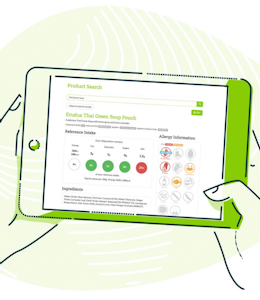Food hypersensitivities explained

In December, having come to the conclusion that they would like to see written allergen information be mandated in the non-prepacked sector, the Food Standards Agency (FSA) made the decision to write to Ministers with the proposal.
And with allergies falling under the umbrella of food hypersensitivities (FHS) - which in their FHS ARI (Area of Research Interest) project the FSA defined as “comprising food allergy, coeliac disease and food intolerance”, we thought it was the perfect time for a refresher on the different types of hypersensitivity and how Erudus can help businesses manage them...
Allergies
What’s an allergy?
An allergy is the body’s immune system reacting to a specific substance as though it is harmful. Foods are one of the main triggers for allergic reactions, but they can also be caused by exposure to things like latex or penicillin.
Allergies affect the immune system - which is there to defend the body against ‘foreign invaders’, and in the case of allergies it misidentifies a harmless substance as a foreign invader - a danger.
The physical effects of an allergic reaction depend on the severity of a person’s allergy. Symptoms can range from mild to acute, and in extreme cases lead to life-threatening anaphylaxis.
Allergies are on the rise and affecting an increasing number of people. They are generally more common in children than adults, though you can develop an allergy at any stage of life.
The 14 major food allergens
14 of the most common food allergies are covered by legislation, in that their inclusion as ingredients in a food product requires particular standards be met for compliance. The EU legislation, EU Food Information Regulation No. 1169/2011 (FIR) and Food Information for Consumers Regulation (FIC) came into force on the 13th December 2014 impacting all Caterers, food Retailers, Wholesalers and foodservice companies.

Caterers and food businesses are required by law to be able to provide customers with accurate information on the EU’s 14 major food allergens if they are included in any of the food products they produce, sell or serve.
The 14 major food allergens are:
Intolerances
What is an intolerance?
An intolerance is the (sometimes delayed) reaction of the body - usually the digestive system - to a particular food or substance. Gluten intolerance and lactose intolerance are two of the most common and well-known examples of a food intolerance.
Many people mistake an intolerance for an allergy, or think that an intolerance is a milder version of an allergy, but they are not the same thing - intolerances do not affect the immune system and allergies specifically affect the body’s immune system.
Food intolerance symptoms can be unpleasant or inconvenient but they are not fatal, and the sufferer can generally tolerate small amounts of their trigger substance.
Because of their link to the digestive system, intolerances are more common in people who suffer from IBS (Irritable Bowel Syndrome) and other digestive conditions.
A person can suffer from an allergy and an intolerance at the same time.
You may also be interested in…


You may also be interested in…
Lactose intolerance - everything you need to know
ReadCoeliac disease
What is Coeliac disease?
Coeliac disease is an auto-immune condition which causes the body to react negatively to gluten, and cause permanent damage if exposure is prolonged. If Coeliacs consume anything containing gluten, it will trigger an immune response that causes damage to the intestinal lining.
Without a diagnosis, if gluten consumption continues it can lead to malabsorption and the inability for the small intestine to absorb nutrients into the bloodstream.
In short, if sufferers consume gluten they will suffer short-term pain and discomfort as well as long-term damage.
Sometimes people confuse Coeliac disease with a gluten allergy or a gluten intolerance, but they are actually all different conditions. With a mild allergy to gluten, the immune response is more often temporary, and unlike Coeliac disease a gluten allergy does not cause permanent damage to the small intestine. However, with a severe gluten allergy the consumption of gluten can cause fatal anaphylaxis.
A gluten intolerance does not affect the immune system, and is sometimes known as a “non-coeliac sensitivity” and causes inflammation throughout the body if gluten is consumed, triggering similar symptoms to Coeliac disease but without the same intensity or long-term consequences.
Sensitivities
What is a food sensitvity?
Sensitivity is often the umbrella term used to describe negative body reactions to specific foods, though the FSA describes these as “hypersensitivities”.
At a basic level, a sensitivity can mean a person’s body metabolising a substance slower or faster than normal. This can lead to them having an exaggerated or enhanced affect from a food or drink - such as experiencing an adrenaline rush and elevated heart beat after consuming a small amount of caffeine.
How Erudus can help food businesses manage allergies
Allergies can pose a fatal threat to those who have them, and with legislation already in place regarding the 14 major food allergens and even more proposed it’s never been more important to understand the allergen content of the foods you are serving or consuming.
That’s why one of the most important functions of the Erudus platform is to provide accurate and up to date allergen and nutritional information about the food products in our Data Pool, and to make this information as easy and efficients to access as possible.
In fact we have several tools that serve this exact purpose. The Erudus Allergen & Nutritional Data Search allows Caterers to find out everything they need to know about the food products they’re using in their business - including the legally required allergen information.
You may also be interested in…


You may also be interested in…
Solutions Spotlight: Allergen & Nutritional Data Search
ReadThe clear, on screen product view displays Reference Intake, Allergens (using traffic light system), Nutrition, Ingredient Declaration and special Dietary needs. This can then be printed or downloaded in PDF or CSV formats and easily referenced by those who need it. The tool is mobile (and tablet) friendly, so it’s also easy for those in the kitchen and front of house to refer to.
The Erudus Recipe Builder is a tool that allows you to automatically aggregate nutritional values, costs and allergy statements for a recipe as you add ingredients (choosing from tens of thousands of branded products in the Erudus Data Pool, thousands of generic food ingredients from the Food Standards Agency and your own custom ingredients).
You can then download a Recipe Card which includes all allergen information for the recipe, which you can reference at your convenience and leisure.
You may also be interested in…


You may also be interested in…
What’s the Difference Between Allergy and Intolerance?
ReadYou may also be interested in…


You may also be interested in…








